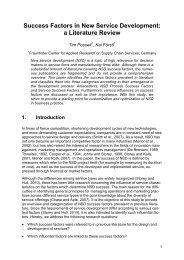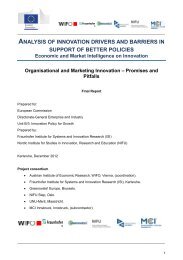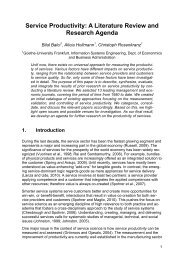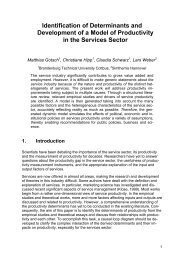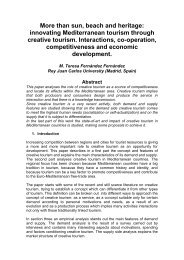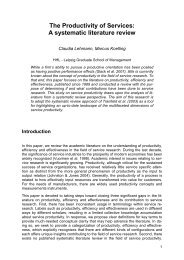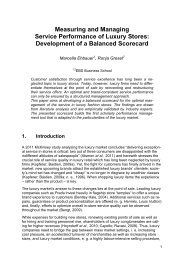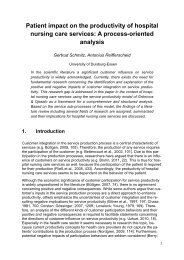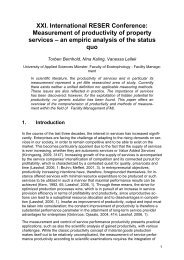Method of collecting and categorising performance ... - RESER
Method of collecting and categorising performance ... - RESER
Method of collecting and categorising performance ... - RESER
Create successful ePaper yourself
Turn your PDF publications into a flip-book with our unique Google optimized e-Paper software.
<strong>Method</strong> <strong>of</strong> <strong>collecting</strong> <strong>and</strong> <strong>categorising</strong><br />
<strong>performance</strong> indicators to measure the<br />
productivity <strong>of</strong> modular services using an IT<br />
tool<br />
Mike Freitag 1 , Sabrina Lamberth 1 , Stephan Klingner 2 , Martin Böttcher 2<br />
1<br />
Fraunh<strong>of</strong>er IAO, 2 University <strong>of</strong> Leipzig<br />
While the question <strong>of</strong> modularisation in the services sector has been<br />
closely examined for a number <strong>of</strong> years already, it is only recently that the<br />
productivity <strong>of</strong> services has been studied in more detail. Experts were<br />
surveyed in order to incorporate their business needs into the process <strong>of</strong><br />
measuring service productivity. Subsequently, a collection <strong>and</strong><br />
categorisation <strong>of</strong> <strong>performance</strong> indicators were suggested based on<br />
previous work. The <strong>performance</strong> indicators could be allocated to the<br />
relevant modules, for instance, using the IT tools introduced here.<br />
1. Introduction<br />
Services are constantly gaining in importance within companies, <strong>and</strong> the proportion<br />
<strong>of</strong> turnover generated by services is continually growing. It is therefore crucial to a<br />
company that it systematically develops <strong>and</strong> provides services as the only way <strong>of</strong><br />
ensuring that customers are indeed <strong>of</strong>fered high-quality services. In this respect, an<br />
important role is played above all by the choice <strong>of</strong> optimum service architecture <strong>and</strong><br />
by the service productivity <strong>of</strong> the individual components <strong>of</strong> that architecture. In<br />
particular, it has to be clarified to what extent the service architecture can be<br />
modularised <strong>and</strong> how productively the chosen architecture can facilitate service<br />
provision. While the question <strong>of</strong> modularisation in the services sector has been<br />
closely examined for a number <strong>of</strong> years already, it is only recently that the<br />
productivity <strong>of</strong> services has been studied in more detail. In this paper, we will take a<br />
closer look at the following points:<br />
• Defining service productivity<br />
• Requirements for compiling productivity <strong>performance</strong> indicators<br />
• Collecting <strong>and</strong> <strong>categorising</strong> productivity <strong>performance</strong> indicators<br />
• Allocating <strong>performance</strong> indicators to individual services or service modules<br />
using an IT tool<br />
• Summary
2. Service productivity <strong>and</strong> controlling<br />
2.1. Service productivity<br />
There is a subcategory <strong>of</strong> economics dedicated to productivity, which generally<br />
denotes the ratio <strong>of</strong> income (output) to expenditure (input) <strong>and</strong> expresses technical<br />
pr<strong>of</strong>itability (Reinecke; Geis, 2006) or, in short, the “Pr<strong>of</strong>itability <strong>of</strong> the operations<br />
factor combination” (Ergiebigkeit der betrieblichen Faktorkombination: Ganz;<br />
Bienzeisler; Tombeil, 2006):<br />
(Productivity = Output/Input)<br />
Productivity is also considered to be a key economic goal for the services sector. In<br />
Germany, services represent nearly 75% <strong>of</strong> companies’ entire revenue (DIN, 2009).<br />
The growing importance <strong>of</strong> services to the total value added makes it necessary to<br />
include them in the internal <strong>performance</strong> accounting <strong>and</strong> to systematically monitor<br />
<strong>and</strong> influence the ratio <strong>of</strong> expenditure to income in the services sector. Based on a<br />
comprehensive look at companies which provide services in Germany – <strong>of</strong> which<br />
approximately 30 per cent were manufacturing companies <strong>and</strong> 70 per cent service<br />
providers in 2008 – the percentage <strong>of</strong> revenue generated by new services is<br />
expected to grow in comparison to the existing portfolio <strong>of</strong> services (Meiren, 2010).<br />
Service productivity represents the efficiency <strong>of</strong> the processes for developing <strong>and</strong><br />
providing services <strong>and</strong> how effectively input resources can be transformed into added<br />
value for the customer <strong>and</strong> economic success for the company (Grönroos; Ojasal,<br />
2004). What sets service productivity apart is that both the provider’s <strong>performance</strong><br />
(input on the side <strong>of</strong> the provider) <strong>and</strong> the client’s input need to be accounted for<br />
(Ganz; Bienzeisler; Tombeil, 2006). While the provider’s <strong>performance</strong> is easier to<br />
quantify <strong>and</strong> is based on large-scale elements such as staff <strong>and</strong> the materials used, it<br />
is more difficult to quantify the client’s <strong>performance</strong>, as this is <strong>of</strong>ten affected by s<strong>of</strong>t<br />
factors such as the client’s willingness <strong>and</strong> expertise. Quantifying <strong>and</strong> evaluating the<br />
shared <strong>performance</strong> <strong>of</strong> the client <strong>and</strong> the service provider can only be achieved<br />
through interaction (communication, coordination <strong>and</strong> collaboration), making it much<br />
more difficult <strong>and</strong> also giving rise to the transaction expenditure associated with<br />
these information <strong>and</strong> communication processes. In addition to integration <strong>of</strong> the<br />
client as an external factor, other specific components influence the service<br />
productivity concept. These include the inability to stock, which, due to its effects on<br />
capacity <strong>and</strong> the commitment to providing services <strong>and</strong> increased flexibility <strong>and</strong><br />
communication, has an influence on result <strong>and</strong> process-related productivity. The fact<br />
that services are intangible has a direct influence on the perception <strong>of</strong> quality on the<br />
side <strong>of</strong> the client, who can only judge the service through experience <strong>and</strong> therefore<br />
needs to believe in the quality from the outset. Heterogeneity represents the fourth<br />
feature <strong>of</strong> services <strong>and</strong> complicates, on the one h<strong>and</strong>, the development <strong>of</strong> an allencompassing<br />
measurement model for service productivity as services are only very<br />
rarely st<strong>and</strong>ard products, <strong>and</strong>, on the other, the configuration <strong>of</strong> a st<strong>and</strong>ard services<br />
package that is simple to manage <strong>and</strong> can be defined with precision. This in turn<br />
impacts on potential, process <strong>and</strong> customer-related <strong>performance</strong> indicators.
Due to the unique features <strong>of</strong> input interactions <strong>and</strong> the input/output relationship, a<br />
comprehensive approach is essential. Grönroos <strong>and</strong> Ojasalo (2004) describe a<br />
concept for measuring service productivity as follows:<br />
Service productivity<br />
= f (internal efficiency, external efficiency, capacity efficiency)<br />
Here it becomes clear that not only internal efficiency is crucial for productivity, but<br />
also external efficiency (i.e. on the side <strong>of</strong> the client). What is more, it is assumed that<br />
capacity in terms <strong>of</strong> service provision must be accounted for in order to identify <strong>and</strong><br />
optimise service productivity.<br />
2.2. Service controlling<br />
Service productivity is measured using <strong>performance</strong> indicators <strong>and</strong> <strong>performance</strong><br />
measurement systems (organised collection <strong>of</strong> various <strong>performance</strong> indicators).<br />
Commonly used <strong>performance</strong> measurement systems include the DuPont System <strong>of</strong><br />
Financial Control, the pr<strong>of</strong>itability <strong>and</strong> liquidity <strong>performance</strong> measurement system, the<br />
ZVEI <strong>performance</strong> measurement system <strong>and</strong> the balanced scorecard. When it comes<br />
to practical applications, which <strong>performance</strong> indicators are suitable for effectively<br />
portraying service productivity, <strong>and</strong> how should they be compiled in order to create<br />
an informative <strong>performance</strong> measurement system customised to meet a company’s<br />
specific needs Clear indicators are necessary both to monitor the pr<strong>of</strong>itability <strong>of</strong><br />
individual services <strong>and</strong> the portfolio <strong>of</strong> services as a whole <strong>and</strong> to provide the input<br />
necessary to plan <strong>and</strong> develop new services or reorganize the service portfolio<br />
structure.<br />
Performance indicators represent a common controlling instrument <strong>and</strong> reflect the<br />
company or sector’s key success factors. Because success can basically be<br />
determined by how these combine <strong>and</strong> interact, several <strong>of</strong> these various “success<br />
indicators” are grouped into <strong>performance</strong> measurement systems. Ideally, individual<br />
informative <strong>performance</strong> indicators are aggregated in company or sector-specific<br />
<strong>performance</strong> indicator catalogues (Kütz, 2007). As such, it would also be plausible to<br />
use specific <strong>performance</strong> measurement systems for service controlling or<br />
supplement the “general” <strong>performance</strong> measurement system with special “service<br />
<strong>performance</strong> indicators” in order to create both an isolated overview <strong>of</strong> the<br />
productivity <strong>of</strong> the services <strong>of</strong>fered <strong>and</strong> the company’s contribution to the total value<br />
added.<br />
One possible type <strong>of</strong> categorisation that can be used to develop service-specific<br />
<strong>performance</strong> measurement systems focuses on the wide range <strong>of</strong> service attributes,<br />
comprising results, potential, process <strong>and</strong> customer-related <strong>performance</strong> indicators.<br />
To integrate service-related <strong>performance</strong> indicators under the classification <strong>of</strong><br />
“general” parameters (e.g. in the product sector), it is possible to integrate a service<br />
component while still maintaining the “general” part. The <strong>performance</strong> indicator<br />
component for services contains a pr<strong>of</strong>itability, liquidity <strong>and</strong> “guarantee <strong>of</strong> continued<br />
existence” component, ideally integrates not only monetary but also qualitative
factors <strong>and</strong> features both operational <strong>and</strong> strategic significance. To operationalise the<br />
quality <strong>of</strong> services, which has a reciprocal effect on productivity, results taken from<br />
customer satisfaction surveys, which reflect the way in which clients perceive the<br />
quality <strong>of</strong> services, are translated into client-specific <strong>performance</strong> indicators <strong>and</strong><br />
integrated into the <strong>performance</strong> measurement systems associated with service<br />
controlling (Ganz; Bienzeisler; Tombeil, 2006). Due to the associative nature <strong>of</strong><br />
services, the assessment criteria represent a combination <strong>of</strong> quantitative <strong>and</strong><br />
qualitative components (Reichwald; Möslein, 1995).<br />
3. Requirements for compiling productivity<br />
<strong>performance</strong> indicators<br />
3.1. Approach to expert interviews<br />
When it came to selecting the company experts to be surveyed, interviews focused<br />
primarily on suppliers <strong>of</strong> technical services who already have experience in<br />
modulating or componentising the services they provide. These “technical services”<br />
refer to services associated with technical products, including industrial services such<br />
as maintenance <strong>and</strong> repair, <strong>and</strong> services associated with technical support, including<br />
IT services. Other criteria such as company size were ignored in the selection <strong>of</strong><br />
companies. The management <strong>and</strong>/or those responsible for designing the range <strong>of</strong><br />
services formed the target group <strong>of</strong> focus within the company, making it possible to<br />
acquire educated statements to current approaches <strong>and</strong> problems.<br />
Conducted in the summer <strong>and</strong> autumn <strong>of</strong> 2010, the interviews focused on in-depth<br />
discussions with representatives from a total <strong>of</strong> 13 companies (Böttcher; Meiren,<br />
2011). Featuring a st<strong>and</strong>ardised framework, the interviews served their purpose well<br />
as the predefined topics provided both an extensive overview into company activities<br />
<strong>and</strong> the freedom to delve further into especially interesting issues. This allowed the<br />
opportunity to take a closer look at companies’ innovative approaches <strong>and</strong> solutions.<br />
3.2. Earlier use <strong>of</strong> <strong>performance</strong> indicators within companies<br />
The four <strong>performance</strong> indicator categories mentioned above were addressed during<br />
the expert surveys <strong>and</strong> supplemented with a financial <strong>performance</strong> indicator,<br />
resulting in the following <strong>performance</strong> indicator categories:<br />
• Market <strong>and</strong> client-related <strong>performance</strong> indicators (e.g. market shares,<br />
customer satisfaction, complaints)<br />
• Result-oriented <strong>performance</strong> indicators (e.g. adherence to schedules, service<br />
level)<br />
• Process-related <strong>performance</strong> indicators (e.g. throughput times, waiting<br />
periods)
• Resource-related <strong>performance</strong> indicators (e.g. utilisation, staff qualification<br />
level)<br />
• Financial <strong>performance</strong> indicators (e.g. revenue, costs, gross margins)<br />
Half <strong>of</strong> the companies surveyed generally rely on market <strong>and</strong> client-related<br />
<strong>performance</strong> indicators to measure customer satisfaction <strong>and</strong> the number <strong>of</strong><br />
complaints received. Finally, these are allocated to categories <strong>of</strong> varying levels <strong>of</strong><br />
urgency.<br />
Result-oriented <strong>performance</strong> indicators are also used by a majority <strong>of</strong> the companies.<br />
“Deadline compliance” in particular was listed frequently, while “service level”<br />
appeared very little in company controlling.<br />
Unlike the first two <strong>performance</strong> indicator categories, process-related <strong>performance</strong><br />
indicators are used by very few companies. Those that do use them <strong>of</strong>ten do so to<br />
measure the throughput times.<br />
Resource-oriented <strong>performance</strong> indicators too are used by few companies. However,<br />
if companies do use them, they attempt to quantify them based on the utilisation <strong>of</strong><br />
their staff or the required qualification level. The required qualification level can then<br />
be used to infer what percentage <strong>of</strong> the employees should be further qualified <strong>and</strong><br />
what percentage <strong>of</strong> the positions will have to be filled again in the future.<br />
The last <strong>performance</strong> indicator category, the financial <strong>performance</strong> indicator, is<br />
unusual in that the majority <strong>of</strong> the companies use it. Nearly all <strong>of</strong> them compile <strong>and</strong><br />
analyse the costs <strong>and</strong> revenue generated by the services. Very few <strong>of</strong> the companies<br />
additionally calculate the gross margins <strong>of</strong> select services. Due to high costs, this is<br />
only done for larger projects. For smaller, advice-intensive projects, only person<br />
months are usually calculated.<br />
3.3. Requirements for compiling productivity <strong>performance</strong><br />
indicators in the future<br />
Productivity <strong>performance</strong> indicators should be systematically used, as they are<br />
essential for service controlling. The development <strong>of</strong> new <strong>performance</strong> indicators, the<br />
expansion <strong>of</strong> existing <strong>performance</strong> measurement systems <strong>and</strong> the compiling process<br />
have to fulfil organisational <strong>and</strong> content requirements. From an organisational point<br />
<strong>of</strong> view, the question <strong>of</strong> measurability <strong>and</strong> generating data from the various serviceproviding<br />
company units must be addressed. In terms <strong>of</strong> productivity <strong>performance</strong><br />
indicator content, it needs to be determined which input <strong>and</strong> output values should be<br />
measured. In other words, which measurement values are suitable for measuring<br />
productivity As a rule, <strong>performance</strong> indicators should be developed <strong>and</strong> used in line<br />
with the aims <strong>of</strong> the company’s service business <strong>and</strong> adequately cover the resource,<br />
process, client <strong>and</strong> result sectors. As such, organisational <strong>and</strong> content requirements<br />
must be compiled in these categories.<br />
In the expert interviews, just over half <strong>of</strong> the companies answered this question.<br />
Moreover, the requirements mentioned were extremely varied. For this reason, they
are displayed in Table 1 in the form on a non-prioritised list. The requirements<br />
compiled are allocated to two categories: data-related <strong>and</strong> tool-related.<br />
Category<br />
Data-related<br />
requirements<br />
(compiling,<br />
organisation <strong>and</strong><br />
evaluation)<br />
Requirements<br />
• Increase in transparency<br />
• The necessity <strong>of</strong> explaining which additional KPIs are<br />
essential to increasing the points <strong>of</strong> reference for the<br />
quality <strong>of</strong> a provided service beyond the binary<br />
question <strong>of</strong> whether a process runs seamlessly or not<br />
• Compiling the gross margins for each project<br />
• Calculating <strong>and</strong> evaluating the average daily rate <strong>of</strong><br />
subcontractors<br />
• Calculating <strong>and</strong> evaluating the average expense ratio<br />
<strong>of</strong> <strong>of</strong>f-shore drilling<br />
• Development <strong>of</strong> threshold specifications in order to<br />
determine at which point productivity is threatened<br />
• Provision <strong>of</strong> KPIs for the process, IT <strong>and</strong> financial<br />
sectors<br />
• Introduction <strong>of</strong> customer satisfaction KPIs for<br />
comprehensive analysis <strong>of</strong> IT-based services<br />
• Analysing service provision time as a central element<br />
<strong>of</strong> productivity, as it plays a crucial role<br />
• Approach to analysing processes carried out at the<br />
client’s facilities <strong>and</strong> incorporating them into the<br />
productivity framework<br />
• Use <strong>of</strong> visualisation applications<br />
• Enabling simple measurement <strong>of</strong> customer<br />
satisfaction<br />
Tool-related<br />
requirements<br />
• Use <strong>of</strong> visualisation applications<br />
• Enabling simple measurement <strong>of</strong> customer<br />
satisfaction<br />
Table 1<br />
Content requirements for developing productivity <strong>performance</strong> indicators in the future<br />
In addition to content requirements, organisational requirements for compiling<br />
productivity <strong>performance</strong> indicators in the future were also addressed. This question<br />
was answered less frequently than that regarding content requirements. For this
eason, the process-related requirements are displayed in Table 2. The requirements<br />
are allocated to two categories: process-related <strong>and</strong> tool-related.<br />
Category<br />
Process-related<br />
requirements<br />
(compiling,<br />
organisation <strong>and</strong><br />
evaluation)<br />
Requirements<br />
• Timely evaluation <strong>of</strong> <strong>performance</strong> indicators <strong>and</strong> the<br />
average expense ratio <strong>of</strong> <strong>of</strong>f-shore <strong>and</strong>/or near-shore<br />
drilling<br />
• Potentially adapting the processes, organisational<br />
structure, IT infrastructure<br />
• Introduction <strong>of</strong> central control mechanisms with the<br />
aim <strong>of</strong> optimising the compiling process<br />
Tool-related<br />
requirements<br />
• Selection <strong>of</strong> potential <strong>performance</strong> indicators from a<br />
single database<br />
• Compilability <strong>of</strong> <strong>performance</strong> indicators as a central<br />
issue: measurement st<strong>and</strong>ardisation, consideration <strong>of</strong><br />
context<br />
Table 2<br />
Organisational requirements for compiling productivity <strong>performance</strong> indicators in the future<br />
4. Collection <strong>and</strong> categorisation <strong>of</strong> productivity<br />
<strong>performance</strong> indicators<br />
From a practical point <strong>of</strong> view, the issue <strong>of</strong> which success indicators are suitable for<br />
portraying service productivity <strong>and</strong> transforming it into a form that can be evaluated<br />
needs to be addressed. In addition to the expert interviews, a comprehensive Excelbased<br />
catalogue consisting <strong>of</strong> 180 productivity <strong>performance</strong> indicators was created in<br />
order to aid in the measurement <strong>of</strong> service productivity <strong>and</strong> integrate an IT tool.<br />
Existing <strong>performance</strong> indicators were collected through wide-scale analysis <strong>of</strong><br />
controlling literature, analysed for suitability for measuring productivity in the services<br />
sector <strong>and</strong> allocated to categories. The suitability analysis <strong>and</strong> categorisation was<br />
carried out objectively, taking into account the wide range <strong>of</strong> service attributes as<br />
identified by Kleinaltenkamp (2001). The resulting framework comprised potential,<br />
process <strong>and</strong> result-oriented dimensions, as well as that <strong>of</strong> the external factor (client),<br />
which introduces itself into the service process <strong>and</strong> therefore incorporates potential,<br />
process, client <strong>and</strong> result-related productivity <strong>performance</strong> indicators. The sectors<br />
measured by the individual <strong>performance</strong> indicator categories are listed in Table 3.
Performance<br />
indicator<br />
category<br />
Potential-related<br />
<strong>performance</strong><br />
indicators<br />
Process-related<br />
<strong>performance</strong><br />
indicators<br />
Result-related<br />
<strong>performance</strong><br />
indicators<br />
Client-related<br />
<strong>performance</strong><br />
indicators<br />
Description (range <strong>of</strong><br />
attributes)<br />
Service providers<br />
possess the ability <strong>and</strong><br />
willingness to provide<br />
services<br />
Providing services is<br />
characterised as a<br />
process<br />
Services can achieve<br />
tangible or intangible<br />
results<br />
The service recipient<br />
introduces itself or a<br />
component into the<br />
process (“external<br />
factor”)<br />
Measurement sector (services)<br />
Resources<br />
Process efficiency, <strong>performance</strong><br />
Monetary <strong>and</strong> qualitative effects (e.g.<br />
benefits for the service provider)<br />
Productivity increase or decrease as<br />
a result <strong>of</strong> client influence in the<br />
services sector, effects on<br />
productivity on the side <strong>of</strong> the client<br />
(e.g. customer satisfaction)<br />
Table 3<br />
Service measurement sectors <strong>and</strong> their productivity <strong>performance</strong> indicators (in-house portrayal<br />
following Kleinaltenkamp, 2001)<br />
The potential dimension represents the provider’s ability <strong>and</strong> willingness to provide a<br />
service <strong>and</strong> is thus related to resources. As such, these <strong>performance</strong> indicators<br />
should be allocated to the following st<strong>and</strong>ard categories: staff, raw materials,<br />
consumables, supplies <strong>and</strong> IT infrastructure (Meiren, Barth, 2002). The process<br />
dimension represents the actual provision <strong>of</strong> services, which is characterised as a<br />
procedure <strong>and</strong> can therefore be subdivided into process steps (Meiren, Barth, 2002).<br />
As a result, <strong>performance</strong> indicators have also been incorporated which make it<br />
possible to evaluate the productivity <strong>of</strong> processes (input – activity – output), thus<br />
forming a link to process efficiency, <strong>and</strong> which also make it possible to demonstrate<br />
productivity values at points <strong>of</strong> intersection. This goes back to the fact that individual<br />
process steps <strong>and</strong> points <strong>of</strong> intersection particularly in process design possess the<br />
potential for productivity loss or optimisation (Meiren, Barth, 2002). Because service<br />
processes have an effect on the recipient or an object (e.g. machines during<br />
maintenance services), the client’s ability <strong>and</strong> characteristics as well as the degree <strong>of</strong><br />
integration into the process <strong>of</strong> providing the service must be taken into account. In<br />
accordance with the wide range <strong>of</strong> service attributes, the effects <strong>of</strong> the services<br />
provided must ultimately be analysed, as they can be tangible or intangible<br />
(Kleinaltenkamp, 2001) <strong>and</strong> <strong>of</strong>fer monetary or qualitative benefits. Analysis <strong>of</strong> these<br />
effects is result-oriented <strong>and</strong> focuses on the financial contribution <strong>of</strong> services.<br />
As with the practical requirements, the focus during collection <strong>and</strong> categorisation <strong>of</strong><br />
the productivity <strong>performance</strong> indicators was on increasing the transparency <strong>of</strong> the<br />
management information <strong>and</strong> in particular developing a solution for evaluating<br />
customer satisfaction, as well as simple classification <strong>and</strong> subdivision <strong>of</strong> the
<strong>performance</strong> indicators into departments <strong>of</strong> service-providing companies, such as IT<br />
<strong>and</strong> financing. Due to the process-like nature <strong>of</strong> services, <strong>performance</strong> indicators<br />
were also concentrated on which in particular take process-relevant factors such as<br />
time, flexibility <strong>and</strong> capacity into account. For the sake <strong>of</strong> transparency <strong>and</strong> quality<br />
optimisation in service controlling, the primary categories were also supplemented by<br />
a subclassification into subcategories, such as quality, financing, quantity <strong>and</strong><br />
market-related <strong>performance</strong> indicators. The aim was to develop a classification that<br />
was extremely straightforward <strong>and</strong> a framework for applying markers to areas <strong>of</strong> IT<br />
support.<br />
In addition to comprehensive descriptions, a definition <strong>and</strong> examples <strong>of</strong> applications<br />
designed to inform the end user, the <strong>performance</strong> indicator catalogue also contains<br />
the corresponding mathematical expression (formula) to aid in the development <strong>of</strong><br />
the IT tool. Table 4 represents a sample entry in the <strong>performance</strong> indicator catalogue.<br />
Title <strong>of</strong><br />
<strong>performance</strong><br />
indicator<br />
Description <strong>of</strong><br />
the <strong>performance</strong><br />
indicator<br />
Formulas<br />
Performance<br />
indicator<br />
application<br />
Reference<br />
Subclassification<br />
I<br />
Subclassification<br />
II<br />
Additional<br />
<strong>performance</strong><br />
indicator<br />
categories<br />
Return on<br />
Complaint<br />
(RoC)<br />
Return on<br />
Complaint<br />
represents the<br />
benefits <strong>of</strong><br />
complaint<br />
management<br />
<strong>and</strong>/or complaintspecific<br />
investments. The<br />
“Benefits <strong>of</strong><br />
complaint<br />
management”<br />
counter can be<br />
operationalised<br />
(e.g. lifetime<br />
increase,<br />
revenue/periods,<br />
etc.) through the<br />
difference<br />
between market<br />
loss with <strong>and</strong><br />
without the<br />
existence <strong>of</strong><br />
complaint<br />
management<br />
Basic<br />
formula:<br />
“return on …”<br />
[in %] =<br />
benefits<br />
within in a<br />
representativ<br />
e<br />
period/capital<br />
investment x<br />
100<br />
The RoC allows<br />
you to<br />
determine the<br />
pr<strong>of</strong>itability <strong>of</strong><br />
complaint<br />
management<br />
<strong>and</strong>/or<br />
individual<br />
measures for<br />
further<br />
developing<br />
complaint<br />
management<br />
Witt, Frank-<br />
Jürgen:<br />
Dienstleistungs<br />
controlling.<br />
Munich 2003.<br />
p. 125;<br />
Brugger, Ralph:<br />
Der IT<br />
Business Case:<br />
Kosten<br />
erfassen und<br />
analysieren -<br />
Nutzen<br />
erkennen und<br />
quantifizieren.<br />
Berlin 2009. p.<br />
179 et seq.<br />
Finances<br />
Quality<br />
Client-related<br />
<strong>performance</strong><br />
indicator<br />
Table 4<br />
Extract from the productivity <strong>performance</strong> indicator catalogue, category: “result-related <strong>performance</strong><br />
indicators” with subcategory (in-house representation)<br />
5. Allocating <strong>performance</strong> indicators to individual<br />
services or service modules using an IT tool<br />
As demonstrated by the results <strong>of</strong> the expert interviews, there is a continued need for<br />
concrete proposals for solutions in the field <strong>of</strong> <strong>performance</strong> indicator integration for<br />
services. Based on these requirements, an IT tool prototype has been developed to<br />
effectively support a management <strong>of</strong> complex services which is both <strong>performance</strong>indicator-based<br />
<strong>and</strong> productivity-oriented.
The productivity observation is especially important with regard to comprehensive<br />
service portfolios. The tool incorporates the modularisation paradigm to create a<br />
manageable design <strong>of</strong> the <strong>performance</strong> indicator, despite its quantitative <strong>and</strong><br />
qualitative complexity (Böttcher, Klingner 2011). Therefore, the first step in using the<br />
tool is the decomposition <strong>of</strong> the monolithic service portfolio into individual modules,<br />
which are then arranged in a hierarchical structure. The “components” represent the<br />
individual service modules, while logical <strong>and</strong> quantitative interdependencies between<br />
the modules are depicted by the connectors within the hierarchy. For example,<br />
Figure 1 shows a detailed view <strong>of</strong> a portfolio structured in this way, whereby the<br />
boxes with angular corners represent the components <strong>and</strong> those with rounded<br />
corners the connectors.<br />
Figure 1: Modular service portfolio<br />
After the hierarchical composition <strong>of</strong> the service portfolio has been modelled, the<br />
<strong>performance</strong> <strong>of</strong> the individual modules can be quantified using productivity<br />
<strong>performance</strong> indicators. An unlimited number <strong>of</strong> productivity <strong>performance</strong> indicators<br />
can be allocated to each component during this stage. A productivity <strong>performance</strong><br />
indicator is calculated using:<br />
• A fixed numeric value<br />
• A calculation rule made up <strong>of</strong> fixed numeric <strong>and</strong> referenced values from other<br />
components<br />
• Referenced values from external programs
Additional functions, such as calculating the minimum value, maximum value or<br />
mean, are also available to this end. Figure 2 shows an example <strong>of</strong> various<br />
<strong>performance</strong> indicators for a component.<br />
Figure 2: Key <strong>performance</strong> indicators<br />
To facilitate the selection <strong>of</strong> the concrete <strong>performance</strong> indicators, the tool is<br />
integrated into the collection <strong>of</strong> productivity <strong>performance</strong> indicators described in<br />
Section 4 . This <strong>performance</strong> indicator catalogue can be referenced to assist in the<br />
creation <strong>of</strong> new <strong>performance</strong> indicators <strong>and</strong> definition <strong>of</strong> the calculation rules for<br />
these indicators. The <strong>performance</strong> indicator catalogue, which contains all<br />
<strong>performance</strong> indicators divided into categories, can be accessed by clicking on the<br />
“Add Characteristic”, (see Figure 3). Because the <strong>performance</strong> indicator can be<br />
filtered based on the service type <strong>of</strong> the corresponding component, categorisation<br />
makes it easier to identify the desired <strong>performance</strong> indicator. Each <strong>performance</strong><br />
indicator includes a brief description <strong>and</strong> list <strong>of</strong> references. If this <strong>performance</strong><br />
indicator is now added to the component, the corresponding formula, whose values<br />
must be determined according to the options listed above, will be provided.<br />
Figure 3: KPI-Library<br />
A service portfolio fully modelled using these methods supports the identification <strong>of</strong><br />
components which could be improved while taking productivity factors into<br />
consideration. Furthermore, it can also be used as the basis for a productivity-
oriented design <strong>of</strong> individual service configurations. During the composition <strong>of</strong> service<br />
modules, the productivity <strong>performance</strong> indicators can be monitored <strong>and</strong> alternative<br />
configurations can, if necessary, be recommended.<br />
6. Summary<br />
The growing importance <strong>of</strong> services to total value added <strong>and</strong> the need to guarantee<br />
high service quality make it necessary to include service-related data in internal<br />
<strong>performance</strong> accounting <strong>and</strong> systematically to monitor <strong>and</strong>/or influence the ratio <strong>of</strong><br />
expenditure to income. This militates in favour <strong>of</strong> service-specific indicators <strong>and</strong><br />
company-specific <strong>performance</strong> measurement systems being used. This approach<br />
was adopted because it is an established <strong>and</strong> user-friendly mix <strong>of</strong> control instruments<br />
<strong>and</strong> because the service-control component can easily be integrated into the<br />
“general” part <strong>of</strong> the <strong>performance</strong> measurement system (e.g. for material assets). On<br />
the basis <strong>of</strong> the segmentation <strong>of</strong> the services sector into “result”, “potential”,<br />
“process” <strong>and</strong> customer” dimensions carried out in the preparatory phase, the project<br />
broke down data into “result-related”, “potential-related”, “process-related” <strong>and</strong><br />
“customer-related” indicators, to which was added the category “financial indicators”<br />
established on the basis <strong>of</strong> interviews. Experts were asked in interviews about these<br />
categories with regard to their importance, acceptance <strong>and</strong> possibilities <strong>of</strong> further<br />
development; <strong>and</strong> the categories were then divided on the basis <strong>of</strong> an analysis <strong>of</strong><br />
their content into 180 indicators <strong>and</strong> aggregated in an indicator catalogue. To<br />
optimise the use <strong>of</strong> <strong>performance</strong> indicators in the services sector, requirements<br />
relating to content <strong>and</strong> organisation were identified.<br />
The results <strong>of</strong> expert interviews reveal the need for solutions to be proposed in this<br />
area. In order to give effective support to the productivity-geared management <strong>of</strong><br />
complex services, an IT tool was developed in the next stage on the basis <strong>of</strong> those<br />
requirements. This enables large service portfolios to be structured into individual<br />
modules <strong>and</strong> the <strong>performance</strong> <strong>of</strong> those modules to be quantified using productivity<br />
indicators. Various means <strong>of</strong> visualisation are used to make even complex service<br />
portfolios with a multitude <strong>of</strong> modules <strong>and</strong> indicators manageable.<br />
References<br />
Böttcher, M.; Klingner, S. (2011): Providing a <strong>Method</strong> for Composing Modular B2B-<br />
Services. In Journal <strong>of</strong> Business <strong>and</strong> Industrial Marketing 26 (5), pp. 320–<br />
331.<br />
Böttcher, M.; Meiren, T. (publisher) (2011): Anforderungen an die Produktivität und<br />
Komponentisierung von Dienstleistungen. Stuttgart: Fraunh<strong>of</strong>er Verlag<br />
(forthcoming).<br />
DIN Deutsches Institut für Normung e. V. (2009): Dienstleistungsst<strong>and</strong>ards in<br />
erfolgreichen Internationalisierungsstrategien. Berlin: Beuth Verlag GmbH<br />
Berlin Vienna Zurich.
Ganz, W.; Bienzeisler, B.; Tombeil, A. (2006): Dienstleistungsproduktivität - Konturen<br />
eines Forschungsfeldes. In: Deryk Streich <strong>and</strong> Dorothee Wahl (publishers):<br />
Moderne Dienstleistungen - Impulse für Innovation, Wachstum und<br />
Beschäftigung; contributions at the 6th BMBF Services Conference.<br />
Frankfurt: Campus Verlag, pp. 315–321.<br />
Grönroos, C.; Ojasalo, K. (2004): Service productivity: Towards a conceptualization<br />
<strong>of</strong> the transformation <strong>of</strong> inputs into economic results <strong>and</strong> services. In: Journal<br />
<strong>of</strong> Business Research (57), pp. 414–423.<br />
Kleinaltenkamp (2001): Begriffsabgrenzungen und Erscheinungsformen von<br />
Dienstleistungen, in: Bruhn, Meffert (publisher): H<strong>and</strong>buch<br />
Dienstleistungsmanagement, Gabler Verlag, Wiesbaden, 2001.<br />
Kütz, Martin (2007): Kennzahlen in der IT. Werkzeuge für Controlling und<br />
Management. 2nd edition <strong>and</strong> exp<strong>and</strong>ed. Heidelberg: dpunkt.verlag<br />
Meiren, T. (2010): “Dienstleistungsentwicklung” study. Stuttgart: Fraunh<strong>of</strong>er IAO.<br />
Available online at<br />
http://www.dienstleistung.iao.fraunh<strong>of</strong>er.de/Images/Studie%20Dienstleistung<br />
sentwicklung_update_tcm383-52772.pdf, most recently updated on<br />
25/01/2011<br />
Meiren, T; Barth, T. (2002): Service Engineering in Unternehmen umsetzen.<br />
Leitfaden für die Entwicklung von Dienstleistungen, IRB Verlag, Stuttgart.<br />
Reichwald, R.; Möslein, K. (1995): Wertschöpfung und Produktivität von<br />
Dienstleistungen - Innovationsstrategien für die St<strong>and</strong>ortsicherung. Munich:<br />
Chair <strong>of</strong> General <strong>and</strong> Industrial Economics.<br />
Reinecke, S.; Geis, G. (2006): Kennzahlengestütztes Marketingcontrolling in<br />
Dienstleistungsunternehmen. In: Manfred Bruhn <strong>and</strong> Bernd Stauss<br />
(publishers): Dienstleistungscontrolling. Wiesbaden: Gabler, pp. 275–299.
Authors:<br />
Mike Freitag<br />
Fraunh<strong>of</strong>er IAO<br />
New Service Development<br />
Nobelstr. 12, 70569 Stuttgart, Germany<br />
Mike.Freitag@iao.fraunh<strong>of</strong>er.de<br />
Sabrina Lamberth<br />
Fraunh<strong>of</strong>er IAO<br />
New Service Development<br />
Nobelstr. 12, 70569 Stuttgart, Germany<br />
Sabrina.Lamberth@iao.fraunh<strong>of</strong>er.de<br />
Stephan Klingner<br />
University <strong>of</strong> Leipzig<br />
Department <strong>of</strong> Computer Science<br />
Johannisgasse 26<br />
04103 Leipzig<br />
Germany<br />
klingner@informatik.uni-leipzig.de<br />
Dr. Martin Böttcher<br />
University <strong>of</strong> Leipzig<br />
Department <strong>of</strong> Computer Science<br />
Johannisgasse 26<br />
04103 Leipzig<br />
Germany<br />
boettcher@informatik.uni-leipzig.de<br />
»Increases in productivity via component-based services« (»Produktivitätssteigerung<br />
durch komponentenbasierte Dienstleistungen«), the joint research project used as<br />
the basis for this publication, is supported by funds from the Federal Ministry <strong>of</strong><br />
Education <strong>and</strong> Research (Bundesministeriums für Bildung und Forschung BMBF)<br />
<strong>and</strong> listed under support codes 01FL09004 <strong>and</strong> 01FL09005. Additional information<br />
on this project can be found online at: http://koproserv.uni-leipzig.de.



